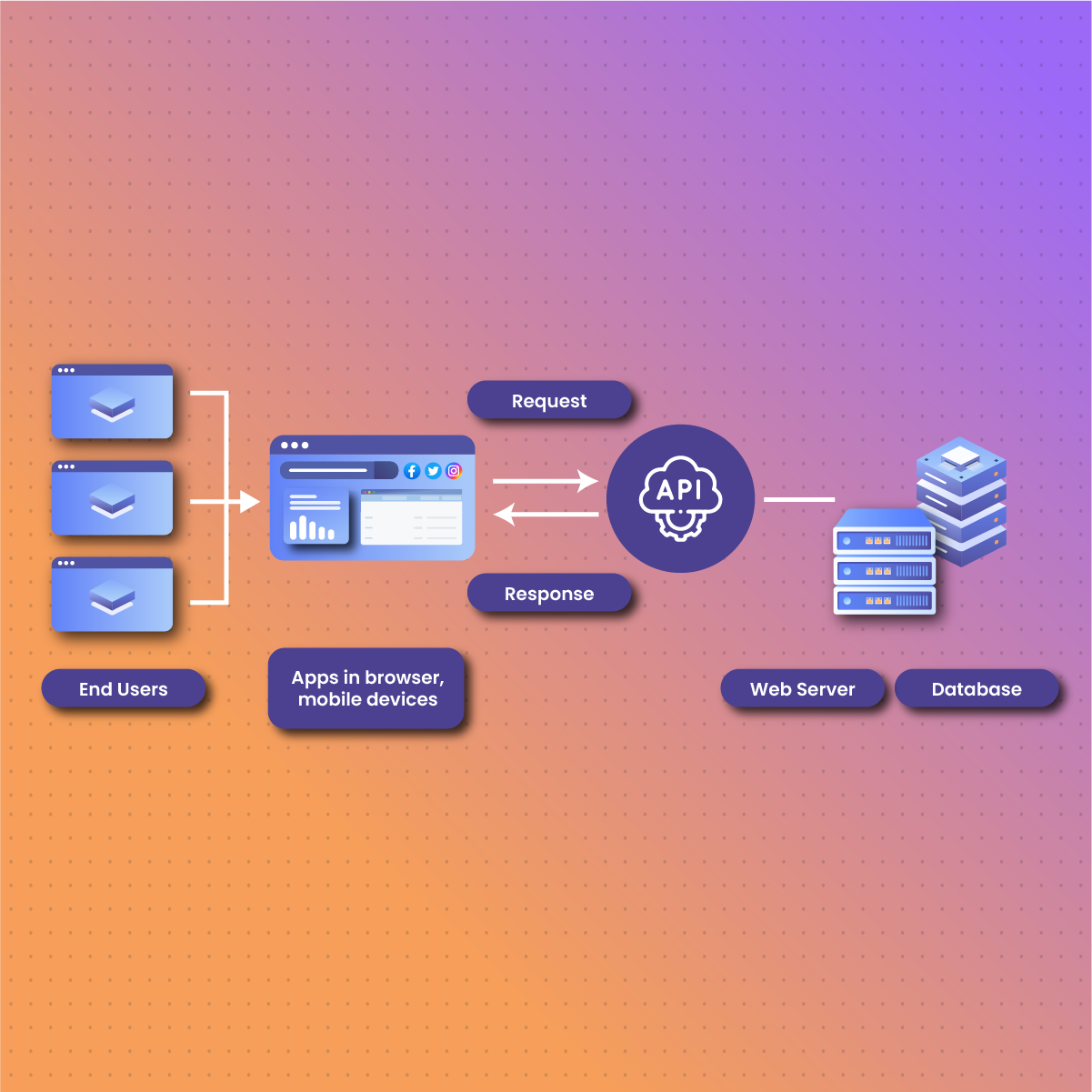Introduction
In the world of technology, APIs might sound like one of those mysterious acronyms that only computer geniuses understand. However, APIs, or Application Programming Interfaces, are not as complicated as they may seem.
Now, you might be wondering, what is an API and why should I care about APIs? Well, APIs are the unsung heroes of modern technology! Imagine you’re using your favorite social media app on your smartphone. Ever wondered how it easily loads new posts or updates your notifications in real-time? That’s all thanks to APIs working behind the scenes, making sure everything runs smoothly.
Now that you have a basic idea of what APIs are and why they’re important, you might be curious to learn more. We got you covered here! This article will break down the concepts into easy-to-understand language, so you don’t need a degree in computer science to understand them.
So, buckle up and get ready to embark on a journey into the world of APIs! Let’s dive in!
What is an API? What to Know About It
API stands for Application Programming Interface. An API is essentially a set of rules and protocols that allows different software applications to communicate with each other. Think of it as a language that software programs use to talk to each other. Just like how you use English to communicate with others, software applications use APIs to exchange information and request services from each other.
How APIs Work
Understanding how APIs work is essential for developers, as it enables them to leverage existing functionality, integrate with external services, and build powerful applications. Here’s a breakdown of how APIs work:
Basic Principles of API Operation
To understand how APIs work, let’s break it down into some basic principles.
- Request and Response: At its best, APIs work on a request-response model. This means that one software application (the client) sends a request to another application (the server) asking for some information or requesting a specific action.
- Defined Interfaces: In addition, APIs provide a set of predefined interfaces or endpoints that clients can use to interact with the server. These interfaces specify the types of requests that can be made, the format of the data that should be sent, and the actions that can be performed.
- Communication Protocol: More so, APIs use a communication protocol to facilitate the exchange of information between the client and server. This could be HTTP (Hypertext Transfer Protocol) for web-based APIs or other protocols like TCP/IP for network communication.
Request-Response Model
Now, let’s go a bit deeper into the request-response model that APIs operate on.
- Client Sends Request: The process starts when the client sends a request to the server using the specified API endpoint. This request typically includes information such as the type of action to perform (e.g., GET, POST, PUT, DELETE) and any additional data needed for the request (e.g., parameters).
- Server Processes Request: Upon receiving the request, the server processes it based on the specified API endpoint and the parameters provided. This could involve querying a database, performing calculations, or invoking other services.
- Server Sends Response: Once the server has processed the request, it sends back a response to the client. This response includes the requested information or indicates the outcome of the requested action. The response typically includes status codes (e.g., 200 for success, 404 for not found) and any relevant data.
Types of APIs
API comes in various types, each serving different purposes and catering to specific development needs. Understanding the different types of APIs is essential for developers to choose the right one for their projects. Here are some common types of APIs:
Web APIs
Web APIs, also known as web services, are APIs that use Hypertext Transfer Protocol (HTTP) to facilitate communication over the internet. They allow different software systems to interact with each other and exchange data using standard web protocols. Examples of web APIs include:
- Twitter API: It allows developers to access and interact with Twitter’s data and functionality, such as posting tweets or retrieving user information.
- Google Maps API: This provides access to Google Maps’ mapping and geolocation services. More so, it allows developers to integrate maps and location-based features into their applications.
Library-based APIs
Library-based APIs provide a set of functions, classes, and procedures that developers can use to perform specific tasks within a programming language or framework. These APIs are often packaged as libraries or modules that developers can include in their projects. Examples of library-based APIs include:
- Standard Template Library (STL) in C++: STL provides a collection of generic algorithms and data structures, such as vectors, lists, and maps. Developers can use this in their C++ programs.
- React.js API: This offers a set of components and functions for building user interfaces in React.js, a popular JavaScript library for building web applications.
Operating System APIs
Operating System (OS) APIs provide interfaces for interacting with various system resources and services provided by an operating system. These APIs allow developers to perform tasks such as file management, memory allocation, process control, and device communication. Examples of operating system APIs include:
- Windows API: Windows allows a set of functions and data structures for developing applications on the Windows operating system. This includes GUI programming, file I/O, and system services.
- POSIX API: POSIX defines a standard API for Unix-like operating systems, including Linux security and macOS, for tasks such as file handling, process management, and interprocess communication.
In summary, there are various types of APIs, each serving different purposes and catering to specific development needs. Whether you’re building web applications, desktop software, or system utilities, understanding the different types of APIs and how they work is essential for effective software development.
API Architectures and Protocols
API architectures and protocols define the structure, design principles, and communication standards that govern how APIs are designed, implemented, and accessed. Getting the knowledge about different API architectures and protocols is crucial for developers to choose the right approach for building scalable, flexible, and efficient APIs. Here, we explore some common API architectures and protocols:
REST APIs
REST, which stands for Representational State Transfer, is an architectural style for designing networked applications. It emphasizes a stateless client-server communication model and leverages standard HTTP methods for interaction. REST APIs are based on the following principles:
- Resource-Based: Resources, such as data objects or services, are represented by URLs (Uniform Resource Locators). Clients interact with these resources using standard HTTP methods like GET, POST, PUT, and DELETE.
- Statelessness: Each request from the client to the server must contain all the information necessary for the server to understand and process it. The server does not maintain any client state between requests.
- Uniform Interface: REST APIs have a uniform and predictable interface, making it easier for clients to understand how to interact with them. This includes using standard HTTP methods, resource identifiers (URIs), and response formats (e.g., JSON or XML).
- Client-Server Architecture: REST architectures separate the concerns of client and server, allowing them to evolve independently. Clients are not concerned with the server’s internal state, and servers are not concerned with the client’s user interface.
- Cacheability: Responses from REST APIs can be cached to improve performance and scalability, reducing the need for repeated requests to the server for the same resources.
SOAP APIs
SOAP, or Simple Object Access Protocol, is a protocol for exchanging structured information in web services. It uses XML (Extensible Markup Language) as its message format and can operate over various transport protocols, including HTTP, SMTP, and TCP. SOAP APIs are based on the following principles:
- Message-Based: SOAP messages are XML-based and contain both the request and response data, along with additional metadata for describing the message structure and processing instructions.
- Protocol-Independent: SOAP can operate over different transport protocols, allowing it to be used in a variety of network environments.
- Extensibility: SOAP supports the use of XML namespaces and schema definitions, making it extensible and customizable for different use cases.
- Security: SOAP provides built-in support for security features such as encryption, authentication, and message integrity, making it suitable for enterprise-level applications.
GraphQL APIs
GraphQL is a query language and runtime for APIs developed by Facebook. It provides a flexible and efficient approach to querying and manipulating data by allowing clients to request only the specific data they need. GraphQL APIs are based on the following principles:
- Hierarchical Structure: GraphQL queries resemble the structure of the data they retrieve, allowing clients to request nested fields and related objects in a single query.
- Strong Typing: GraphQL schemas define a strict type system for the data exposed by the API, ensuring type safety and consistency across queries and responses.
- Client-Defined Queries: Clients can specify exactly which fields they want to retrieve in a GraphQL query, avoiding over-fetching or under-fetching of data.
- Single Endpoint: GraphQL APIs typically expose a single endpoint for all operations, simplifying client-server communication and reducing network overhead.
Comparison with REST and SOAP
- Flexibility: GraphQL offers greater flexibility and control over data retrieval compared to REST APIs, which often require multiple endpoints for different resource representations.
- Efficiency: GraphQL can be more efficient than REST APIs in scenarios where clients need to retrieve complex or nested data structures. It allows clients to request only the data they need in a single query.
- Learning Curve: GraphQL has a steeper learning curve compared to REST APIs. This is due to its unique query language and concepts such as schemas and resolvers.
- Tooling: GraphQL tooling and ecosystem are still evolving compared to the mature tooling available for REST APIs, but GraphQL is gaining popularity and adoption in the developer community.
In summary, each API architecture and protocol has its own strengths and weaknesses. Also, the choice between them depends on factors such as the specific requirements of the application, and the needs of the target audience.
Best Practices for Working with APIs: Integrating with NetNut Proxies
NetNut offers a powerful solution for enhancing your application’s connectivity, security, and performance by providing a reliable proxy network. Integrating NetNut proxies with your API can unlock a range of benefits, from improved data access to enhanced privacy and security.
Before integrating NetNut proxies with your API, it’s essential to familiarize yourself with their features and capabilities. NetNut provides a global proxy network with residential IP addresses, mobile proxies, and ISP proxies. They enable you to route your API requests through distributed proxy servers for improved reliability and anonymity.
Here’s how you can integrate NetNut proxies with your API:
Configure Proxy Settings
Once you have your NetNut proxy credentials, configure your API client to use NetNut proxies for outbound requests. Most HTTP client libraries and frameworks support proxy settings configuration, allowing you to specify the proxy host, port, username, and password provided by NetNut.
Test Integration
Before deploying your application to production, thoroughly test the integration of NetNut proxies with your API. Send test requests through the proxy network and verify that the responses are received correctly. Test various use cases and scenarios to ensure robustness and reliability.
Handle Authentication
If your API requires authentication, ensure that your proxy configuration includes the necessary credentials for authentication with the API server. This may involve passing authentication headers or tokens along with your requests through the NetNut network.
Monitor Performance
Monitor the performance of your API requests when routed through NetNut proxies to ensure optimal performance and minimal latency. NetNut proxies offer advanced performance monitoring tools and analytics dashboards to track request throughput, latency, and success rates.
Handle Errors and Failures
Implement robust error handling and failure recovery mechanisms in your API client to gracefully handle errors and failures when communicating through NetNut proxies. Implement retry strategies, fallback mechanisms, and error logging to mitigate disruptions and maintain uptime.
By following these steps, you can easily integrate NetNut proxies with your API to unlock enhanced connectivity, security, and performance for your applications. Whether you’re building web scrapers, data mining tools, or high-traffic applications, NetNut proxies provide a reliable and scalable solution for proxy management and data access.
Conclusion
On a final note, APIs have emerged as the unsung heroes of modern technology. They serve as the essential conduits through which software systems communicate, and collaborate. This further powering the easy experiences we’ve come to expect in our online activities.
APIs play a crucial role in driving innovation, enabling integration, and powering digital transformation in today’s interconnected world. From social media platforms and e-commerce websites to mobile apps and IoT devices, APIs are the building blocks that make modern technology possible.
Without APIs, many of the digital experiences we take for granted today would not exist. APIs empower developers to create new applications, leverage existing services, and unlock new possibilities for collaboration and creativity. They enable businesses to streamline operations, reach new markets, and deliver seamless user experiences across multiple platforms and devices.
In summary, APIs are the silent weapons behind the scenes, facilitating the flow of data and functionality that powers our digital lives. They are the glue that holds the digital ecosystem together, connecting separate systems and services and driving innovation at every turn.
Therefore, with the tips highlighted above, optimize API functionality to the fullest. Unlock unlimited horizons of technology and innovation!
Frequently Asked Questions and Answers
What is the difference between RESTful APIs and SOAP APIs?
RESTful APIs follow a lightweight, stateless architecture based on standard HTTP methods, while SOAP APIs use a more rigid XML-based messaging protocol. RESTful APIs are simpler, more flexible, and better suited for web-based applications, while SOAP APIs are often used in enterprise environments for complex, transactional systems.
What are the potential pitfalls and challenges when working with APIs?
Common pitfalls and challenges when working with APIs include overlooking documentation, security vulnerabilities, lack of proper error handling and testing, versioning issues, and compatibility problems.
What are some best practices for working with APIs?
Best practices for working with APIs include documenting APIs comprehensively, versioning APIs effectively, and prioritizing security considerations. Other practices include- implementing proper error handling and testing, and choosing the right API based on factors like scalability, security, and compatibility.









